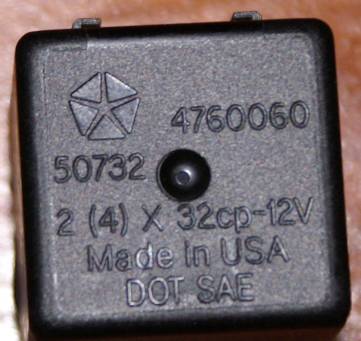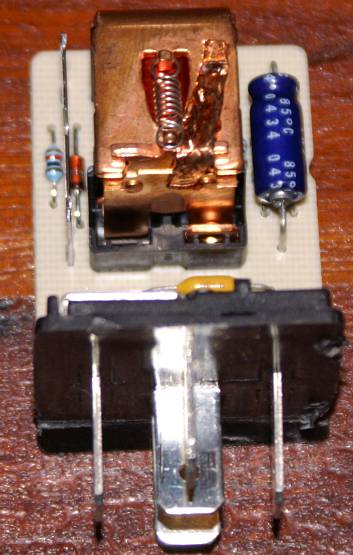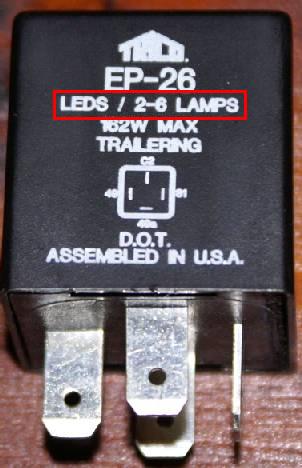A reference or two about Robert shows up in and LED tail light install write-up here on the site. Robert was good enough, some time back, to send me one of the new Trico Electronics manufactured LED flashers. He is a pretty good source of information when it comes to flashers. When I saw that Robert had gathered together info about TJ flashers, I asked him if I could host his flasher FQA here so that it could be more easily shared with the other TJ owners. Robert graciously agreed and so here is his FAQ. Thank you Robert for providing us with some good flasher information.
A short comment from Robert: Disclaimer – I work for Trico Electronics. This FAQ is not designed to push our product, but to offer the best solution to TJ owners like myself.
1. What turn signal module does my TJ have?
2. Why do my turn signals flash fast?
3. How do I make my turn signals stop flashing fast if I replace my bulbs with LED’s?
4. Where can I get a replacement turn signal module?
5. Where is my turn signal module?
6. My hazards work, but my turns don’t.
7. My turn signal makes the ticking noise without the turn switch activated.
1. What turn signal module does my TJ have?

1997-2000 Models have a 4 pin turn signal flasher. All the part numbers are molded into the plastic. A representative flasher top looks like the above photo.

The 4 pin model internals are shown in the above photo.

2001+ models have a 5 pin turn signal module. The markings are also molded into the plastics.

The 5 pin model internals are shown in the above photo.
2. Why do my turn signals flash fast?
The Society of Automotive Engineers (SAE) requires that all Department of Transportation (DOT) approved turn signal modules give a visual indicator to the operator of the vehicle if a bulb is burned out. This mode is called “outage.” The TJ flasher does this by sensing the current draw, if it is below the draw of 2 bulbs the module doubles the flash rate. If you have not modified your turn signal circuit (aftermarket bulbs, LED’s, etc.), you may have a burned out bulb. Check this first. If you have modified your circuit with aftermarket bulbs or LED’s, you are probably drawing less current than the stock bulb setup, and have tricked the flasher into thinking a bulb is burned out.
3. How do I make my turn signals stop flashing fast if I replace my bulbs with LED’s?
There are 3 options for solving the fast flash problem. ALL of them will eliminate the outage feature, so you will have to figure out burned out bulbs on your own. The first option is to modify your OE flasher. The second option is to install load resistors, however this is not recommended. Load resistors increase the current draw above the outage level by burning off current as heat, and can be a hazard if not done correctly. They are not typically cheaper than the other two options, so there is no advantage. The third option is to purchase an LED capable flasher.
1997-2000 Models:
Modifying your own – If you have only put LED’s on one end of your TJ, this option is free and easy. An excellent write-up can be found on Stu’s site here. If you have LED’s at all corners of your TJ, the stock flasher may not receive enough current to operate. A minimum of 640 mA is required for the OE flasher to function, I have seen full LED setups that do not pull this much current. Under this scenario, your stock flasher will not work EVEN IF YOU DO THE LED MOD. You will know if this happens.

Purchasing an LED capable flasher – Trico Electronics now manufactures an LED capable flasher. It can handle LED’s in either configuration of front, rear, or combo. You should look for a module with the words “LEDS” as marked in this photo.
2001+ Models:
Modifying your own – A little more difficult than on the earlier models, and has some associated costs. If you are handy with a soldering iron, or willing to learn, instructions can be found here. This is one way to use LED’s and get full OE functionality in the 2001+ models. As with the earlier models there is a current limitation. If you have LED’s at all corners of your TJ, the stock flasher may not receive enough current to operate. A minimum of 640 mA is required for the OE flasher to function, I have seen full LED setups that do not pull this much current. Under this scenario, your stock flasher will not work EVEN IF YOU DO THE LED MOD.
Purchasing an LED capable flasher – I do not know of an LED capable flasher that offers full OE functionality. The EP26 will fit, and will offer normal turn and hazard operation. This is not an official solution, if you leave your turn signals on when you turn off ignition, they will not turn off. You could drain your battery – you will have to remember to turn off your turn signals.
NOTE from Stu: As of early 2008, a no modification drop in replacement flasher is available. See this write-up.

You should look for a module with the words “LEDS” as marked in this pic.
4. Where can I get a replacement turn signal module?
You can get an OE style module at your dealer. If you are not planning on installing LED’s and want to keep the outage function, this is the only option. It will have a very large markup unless you have a friend in the dealership.
You can get an EP26 at most major parts stores.
5. Where is my turn signal module?
Stu has excellent write-ups for both the 1997-2000 and the 2001+ model TJs.
6. My hazards work, but my turns don’t.
This could be your combo switch. The turn signal module is switched in and out for left, right or turn. So if one of these functions work, it is most likely that your turn module is good but the switching is bad. Try jiggling the hazard switch while trying turn. This is a fairly common failure.
7. My turn signal makes the ticking noise without the turn switch activated.
This is typically preceded by having your top off in the rain. This is NOT a turn signal module problem, and replacing it will not solve the problem. Waiting for the vehicle to dry out will fix the problem. A more proactive approach is to remove the turn signal module, spray the socket out with WD-40, and allow it to dry. Replace the turn signal module and insulate it with electrical tape, or some type of boot between the module and the socket.